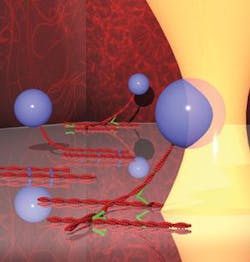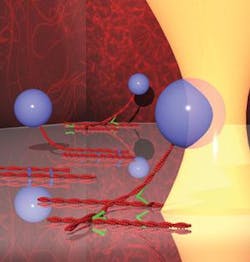MOLECULAR BIOLOGY: Tweezing out the ultrasmall
Life scientists have long used optical tweezers—laser beams that trap, pick up, and move objects—to carry out manipulations of particles of micron size. Now, several teams have begun to apply the technology to the ultrasmall scale. Groups in Asia, Europe, and North America have used optical tweezers to measure bonds between proteins, to manipulate DNA chains, and to probe blood cells.
Traditional optical tweezers work like microminiaturized versions of mechanical tweezers. Scientists first use the radiation pressure from a highly focused laser beam to trap micron-scale objects of interest near the beam’s focus. Then they move the objects around by adjusting the beam’s position. The technology has the ability to trap items as small as individual atoms. But it encounters two problems when applied to life-science research. Capturing nanoscale samples requires laser powers so high that they can damage or destroy the samples. And the smaller the objects under investigation the greater is their random Brownian motion; that makes it increasingly difficult to capture the tiniest objects.
Lower-power lasers
A group at the University of Manchester, England, has devised a new type of optical tweezers that overcomes both problems. The team, lead by Alexander Grigorenko, uses electromagnetically coupled pairs of gold microdots that create an array of optical traps with higher capturing efficiency than usual. The traps occupy less volume than traditional ones, which makes it possible to reduce the amount of laser power necessary to capture samples. “Our tweezers achieve control of entities at significantly smaller laser powers and open new avenues for nanomanipulation of fragile biological objects,” Grigorenko explains. The group reports its results in Nature Photonics.
Other research teams have developed their own approaches to optically tweezing ultrasmall biological objects. A group at MIT, for example, used the technology for the first time to measure interactions between single protein molecules. Headed by Matthew Lang, assistant professor of biological and mechanical engineering, the group targeted proteins that bind to actin filaments. These components of the cytoskeleton can provide structural support to cells, help cells to crawl across surfaces or, in the case of muscle cells, sustain loads.
To study interactions among the proteins, the team anchored one protein and used a laser beam to pull another away from it until the bond mediated by the actin-binding protein broke. That approach, the team reports in the Proceedings of the National Academy of Sciences, gave an accurate measure of the force between the two. According to Lang, researchers can use the method to study many of the hundreds of other protein-protein interactions that occur in nature. “We’re trying to understand how nature engineered these molecular linkages to use in different ways,” he explains. “The technique is really giving us a molecular-level picture of what’s going on.”
Dealing with DNA
On an even smaller scale, researchers have used optical tweezers to study DNA. A group of scientists from Kyoto and Tokyo Universities in Japan has developed a device based on optical tweezers that sews long threads of DNA into shape and winds long chains of the molecules into manageable lengths that can be studied accurately. The optical tweezers control a microhook that picks up and straightens out individual strands of DNA. The tweezers also serve to wind microminiature “bobbins” built into the DNA chains onto tiny spindles. Prepared in this way, the DNA chains can be examined by fluorescence spectroscopy for evidence of markers that indicate the presence of genetic disorders.
At Northeastern University in Boston, Mark Williams, associate professor of physics, and graduate student Thaya Paramanathan have used optical tweezers for another DNA-related project: studying interactions between DNA molecules and the molecules of possible drug formulations. The group uses the optical tweezers to grab the ends of a DNA double helix and stretch out the interwoven strands. The approach allows the strands to separate faster to interact with other molecules. A drug molecule slides in between the strands and remains there when the strands reunite. “By studying this threading mechanism on a single DNA molecule,” Williams explains, “we were able to directly measure the physical characteristics of the interactions of the DNA and potential DNA binding drugs.” The advance, reported in the Journal of the American Chemical Society, promises to help the development of drugs that can inhibit or prevent the replication of mutated cells.
The Raman combination
Scientists from the University of Naples Federico II have combined optical tweezers with Raman spectroscopy to study blood diseases related to hemoglobin, such as thalassemia. The team, headed by Guilia Rusciano, uses a ND:YAG laser operating at 1064 nm to trap red blood cells and a frequency-doubled ND:YVO laser at 532 nm to excite the Raman signals. The combination, reported in Optics Express, enables study of the oxygenation capacity of hemoglobin, the elastic properties of red blood cells, and light damage to cells at different wavelengths. –PG

